Analysis of Land Use Changes in the Sado Estuary (Portugal) from the 19th to the 21st Century, Based on Historical Maps, Fieldwork, and Remote Sensing
Abstract
1. Introduction
2. Materials and Methods
2.1. Regional Characterization
2.2. Methodological Approach
3. Results
3.1. Historical Land Use and Occupation
3.2. 21st Century Land Use and Occupation
4. Discussion
5. Conclusions
Author Contributions
Funding
Institutional Review Board Statement
Informed Consent Statement
Data Availability Statement
Acknowledgments
Conflicts of Interest
References
- Fasona, M.; Omojola, A. Land cover change and land degradation in parts of the southwest coast of Nigeria. Afr. J. Ecol. 2009, 47, 30–38. [Google Scholar] [CrossRef]
- de Jong, R.; de Bruin, S.; Schaepman, M.; Dent, D. Quantitative mapping of global land degradation using Earth observations. Int. J. Remote Sens. 2011, 32, 6823–6853. [Google Scholar] [CrossRef]
- Bajocco, S.; De Angelis, A.; Perini, L.; Ferrara, A.; Salvati, L. The impact of land use/land cover changes on land degradation dynamics: A Mediterranean case study. Environ. Manag. 2012, 49, 980–989. [Google Scholar] [CrossRef] [PubMed]
- Mbow, C.; Brandt, M.; Ouedraogo, I.; De Leeuw, J.; Marshall, M. What four decades of earth observation tell us about land degradation in the Sahel? Remote Sens. 2015, 7, 4048–4067. [Google Scholar] [CrossRef]
- Nagendra, H.; Mairota, P.; Marangi, C.; Lucas, R.; Dimopoulos, P.; Honrado, J.P.; Blonda, P. Satellite Earth observation data to identify anthropogenic pressures in selected protected areas. Int. J. Appl. Earth Obs. Geoinf. 2015, 37, 124–132. [Google Scholar] [CrossRef]
- Singh, S.K.; Srivastava, P.K.; Szabó, S.; Petropoulos, G.P.; Gupta, M.; Islam, T. Landscape transform and spatial metrics for mapping spatiotemporal land cover dynamics using Earth Observation datasets. Geocarto Int. 2017, 32, 113–127. [Google Scholar]
- Xie, Z.; Phinn, S.R.; Game, E.T.; Pannell, D.J.; Hobbs, R.J.; Briggs, P.R.; McDonald-Madden, E. Using Landsat observations (1988–2017) and Google Earth Engine to detect vegetation cover changes in rangelands-A first step towards identifying degraded lands for conservation. Remote Sens. Environ. 2019, 232, 111317. [Google Scholar] [CrossRef]
- Giuliani, G.; Chatenoux, B.; Benvenuti, A.; Lacroix, P.; Santoro, M.; Mazzetti, P. Monitoring land degradation at national level using satellite Earth Observation time-series data to support SDG15–exploring the potential of data cube. Big Earth Data 2020, 4, 3–22. [Google Scholar] [CrossRef]
- Available online: https://sustainabledevelopment.un.org/content/documents/5987our-common-future.pdf (accessed on 10 April 2024).
- Available online: https://sustainabledevelopment.un.org/outcomedocuments/agenda21 (accessed on 10 April 2024).
- Cole, D.G. Placing History: How Maps, Spatial Data, and GIS Are Changing Historical Scholarship. Cartogr. Perspect. 2009, 63, 66–69. [Google Scholar] [CrossRef]
- Piškinaitė, E.; Veteikis, D. The Results of Digitizing Historical Maps: Comparison of Lithuanian Land-Use Structure in the 19th and 21st Centuries. Land 2023, 12, 946. [Google Scholar] [CrossRef]
- Inácio, M. Evolução Morfossedimentar do Sapal da Caldeira de Tróia em Contexto de Subida do Nível Médio do Mar. Ph.D. Thesis, ULisboa, Lisbon, Portugal, 2017. Available online: https://repositorio.ul.pt/handle/10451/31656 (accessed on 10 April 2024).
- Brito, P. Impactos da Elevação do Nível Médio do mar em Ambientes Costeiros: O Caso do Estuário do Sado. Ph.D. Thesis, ULisboa, Lisboa, Portugal, 2009. Available online: http://hdl.handle.net/10451/3151 (accessed on 10 April 2024).
- Available online: https://www.ipma.pt/pt/oclima/series.longas/?loc=Set%C3%BAbal&type=raw (accessed on 10 April 2024).
- Pimentel, N.L. O terciário da Bacia do Sado: Sedimentologia e Análise Tectono-Sedimentar. Ph.D. Thesis, ULisboa, Lisboa, Portuguese, 1997. Available online: https://www.researchgate.net/publication/356814643 (accessed on 10 April 2024).
- Available online: https://www.dgadr.gov.pt/cartografia/cartas-pery/carta-agricola-50000 (accessed on 10 April 2024).
- Available online: https://smos.dgterritorio.gov.pt/cartografia-de-uso-e-ocupacao-do-solo (accessed on 10 April 2024).
- Available online: http://apambiente.pt/_zdata/Politicas/Agua/PlaneamentoeGestao/PGRH/20162021/PTRH6/PGRH6_Parte2.pdf (accessed on 10 April 2024).
- Costa, A.M.; Freitas, M.C.; Mota, R.; Leira, M.; Andrade, C.; Pimentel, N.; Araújo, A.C.; Bao, R.; Diniz, M.; Arias, P. Sado palaeovalley configuration: Implications for the Mesolithic settlement during the Holocene sea-level rise. In People, Nature and Environments: Learning to Live Together, Part 4—Landscape and Heritage; Roque, A., Brito, C., Veracini, C., Eds.; Cambridge Scholars Publishing: Cambridge, UK, 2020; Chapter Thirteen; pp. 176–194. [Google Scholar]
- Clark, P.U.; Dyke, A.S.; Shakun, J.D.; Carlson, A.E.; Clark, J.; Wohlfarth, B.; Mitrovica, J.X.; Hostetler, S.W.; McCabe, M. The Last Glacial Maximum. Science 2009, 325, 710–714. [Google Scholar] [CrossRef] [PubMed]
- Carvalho, A.F. O Mesolítico Final em Portugal. In El Mesolítico Geométrico en la Península Ibérica; Miranda, U., Ramirez, M., Eds.; Monografías Arqueológicas; Universidad de Zaragoza: Zaragoza, Spain, 2009; Volume 44, pp. 33–68. [Google Scholar]
- Mayet, F.; Tavares da Silva, C. Roman Amphora Production in the Lower Sado Region. In Lusitanian Amphorae: Production and Distribution; Pinto, I.V., de Almeida, R.R., Martin, A., Eds.; Archaeopress Publ. Ltd.: Oxford, UK, 2016; pp. 59–72. Available online: http://hdl.handle.net/10451/31694 (accessed on 10 April 2024).
- Quintas, M.C. Setúbal: Economia, Sociedade e Cultura Operária: 1880–1930; Livros Horizonte: Lisboa, Portuguese, 1998; 568p, ISBN 978-972-24-1028-8. [Google Scholar]
- Belo, C.C.; Coelho, I.; Rolo, J.; Reis, P. Sistemas agroflorestais em Portugal continental. Parte II: Montados, condições de uso do solo e evolução. Rev. Ciências Agrárias 2014, 37, 122–130. [Google Scholar]
- Available online: https://dspace.uevora.pt/rdpc/bitstream/10174/3547/1/9CNA%20Caveira.pdf (accessed on 10 April 2024).
- Available online: https://siaia.apambiente.pt/AIADOC/PA444/rm%202012201941813153.pdf (accessed on 10 April 2024).
- Available online: https://www.icnf.pt/api/file/doc/89d8861657451075 (accessed on 10 April 2024).
- Carmo, M. Solo e Agricultura no Século XX Português–um Problema Ambiental, Histórico e Epistemológico. Tese de Doutoramento (unpubl) 2018. Universidade de Lisboa. Available online: http://hdl.handle.net/10400.5/17510 (accessed on 16 June 2022).

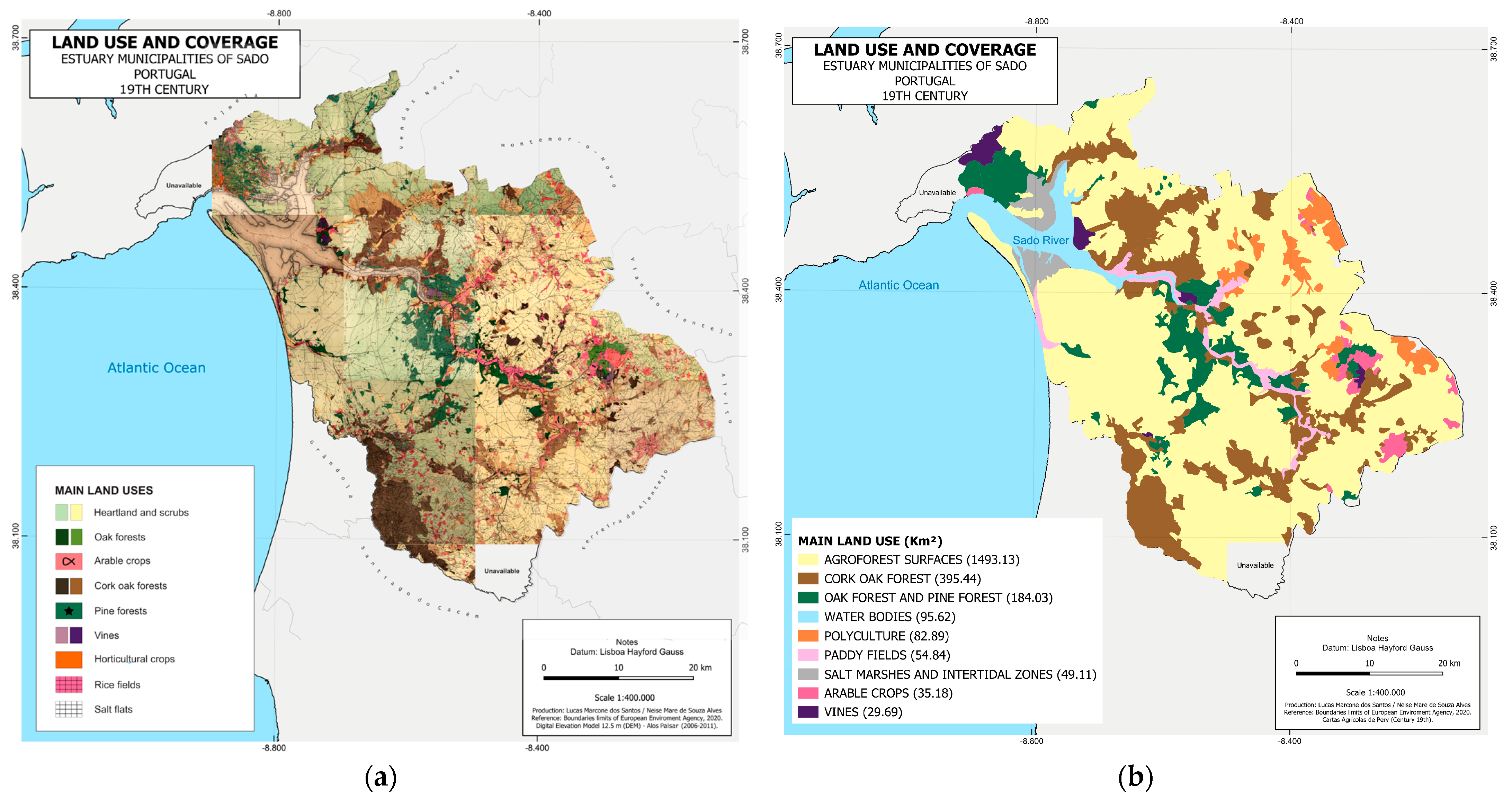
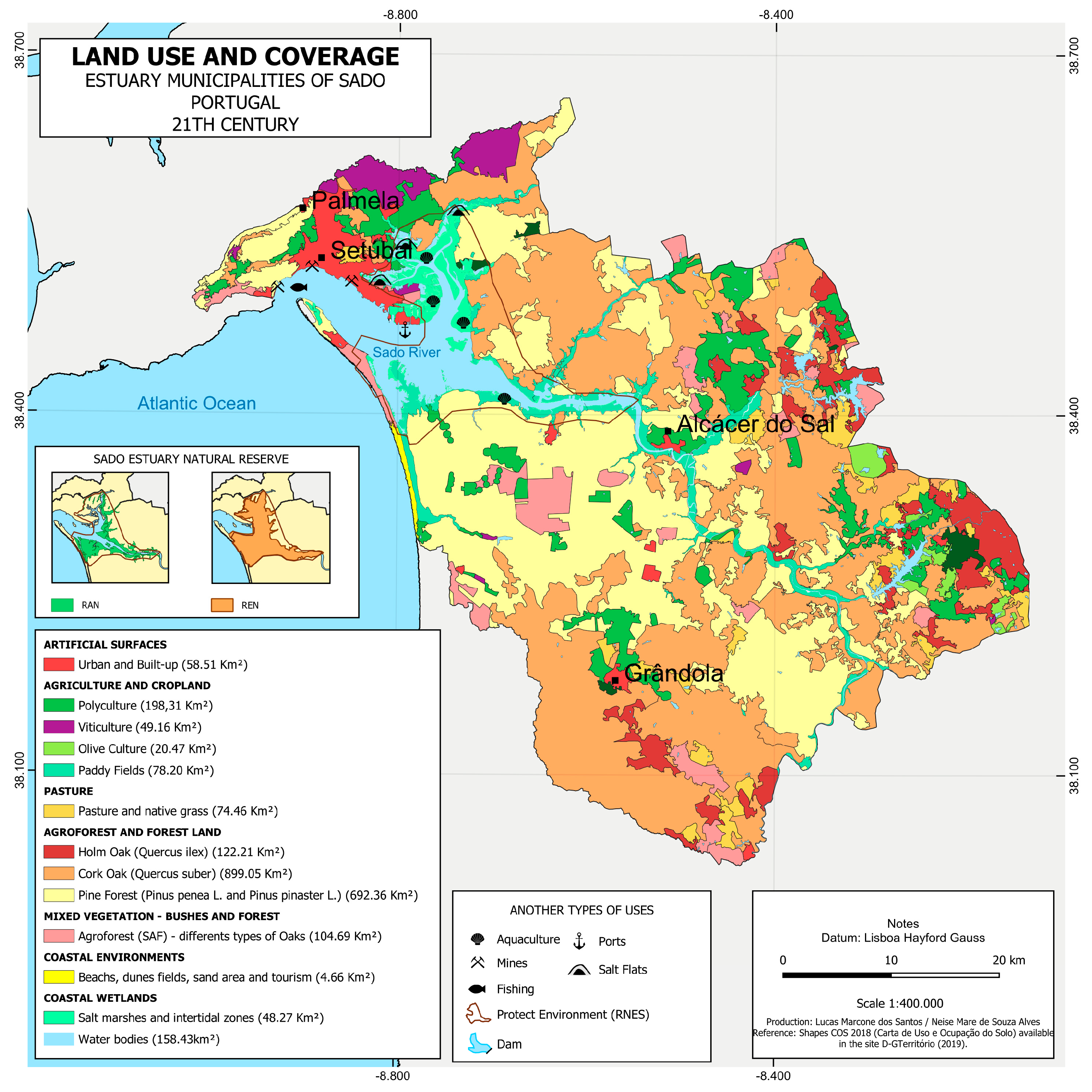
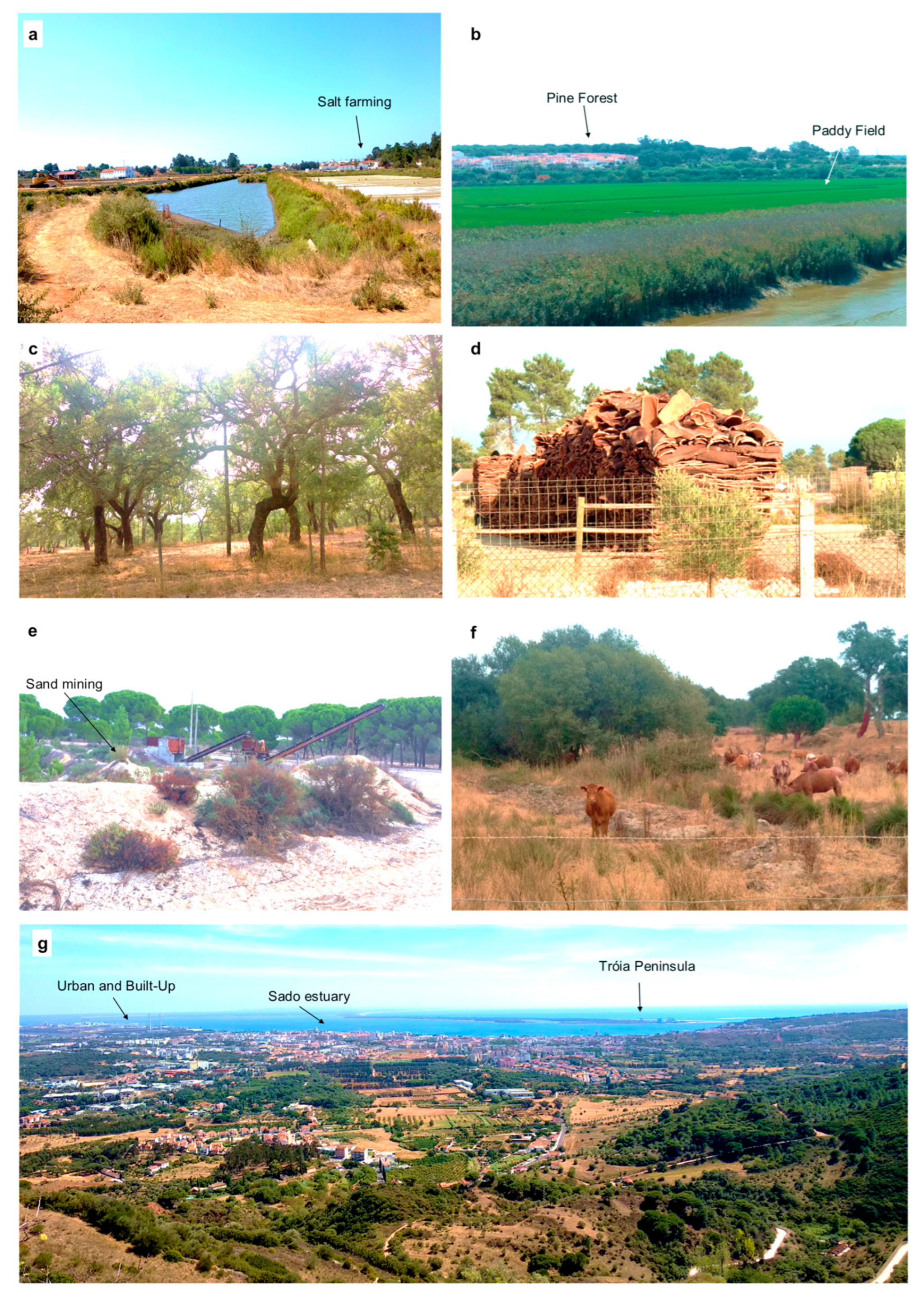
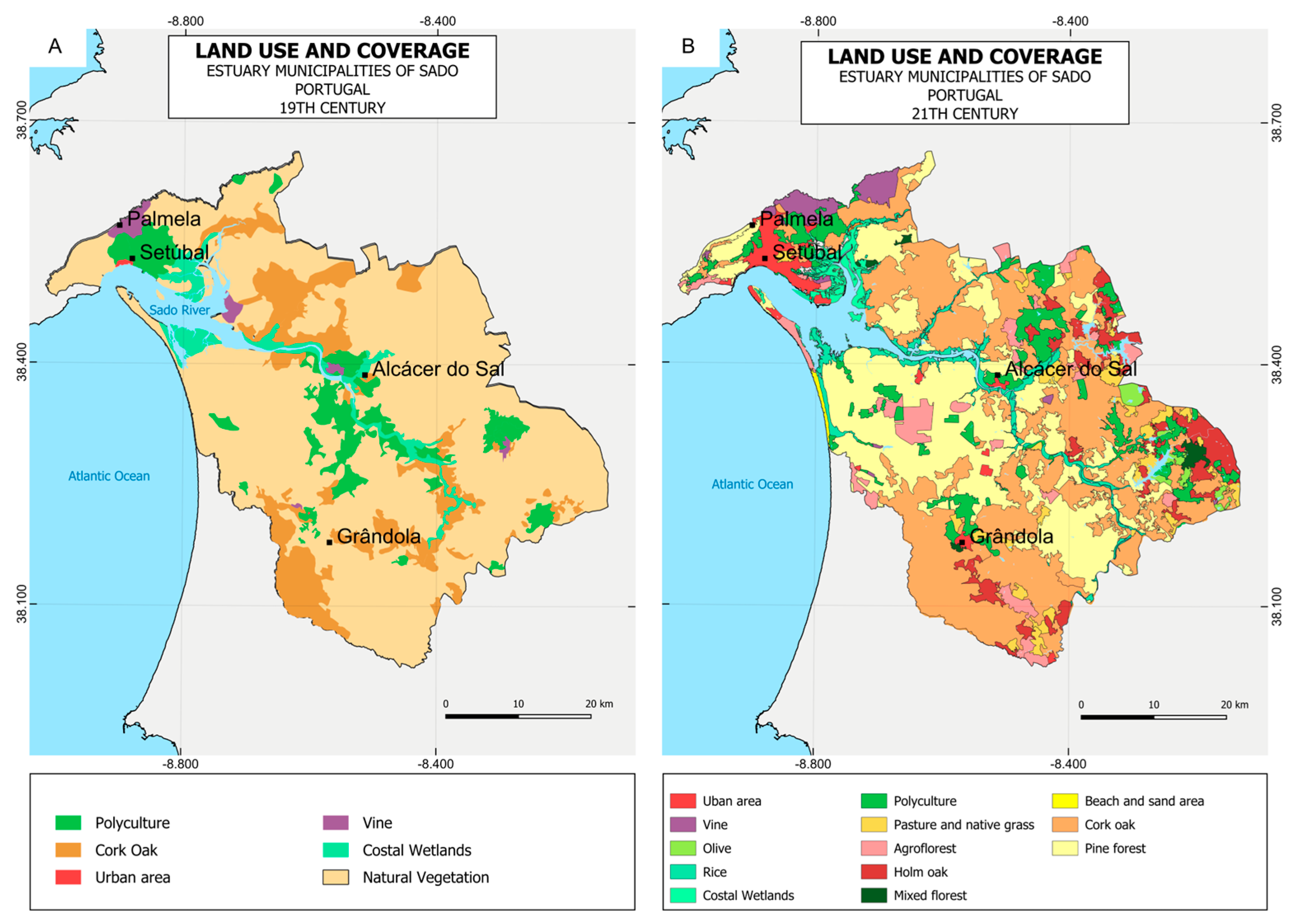
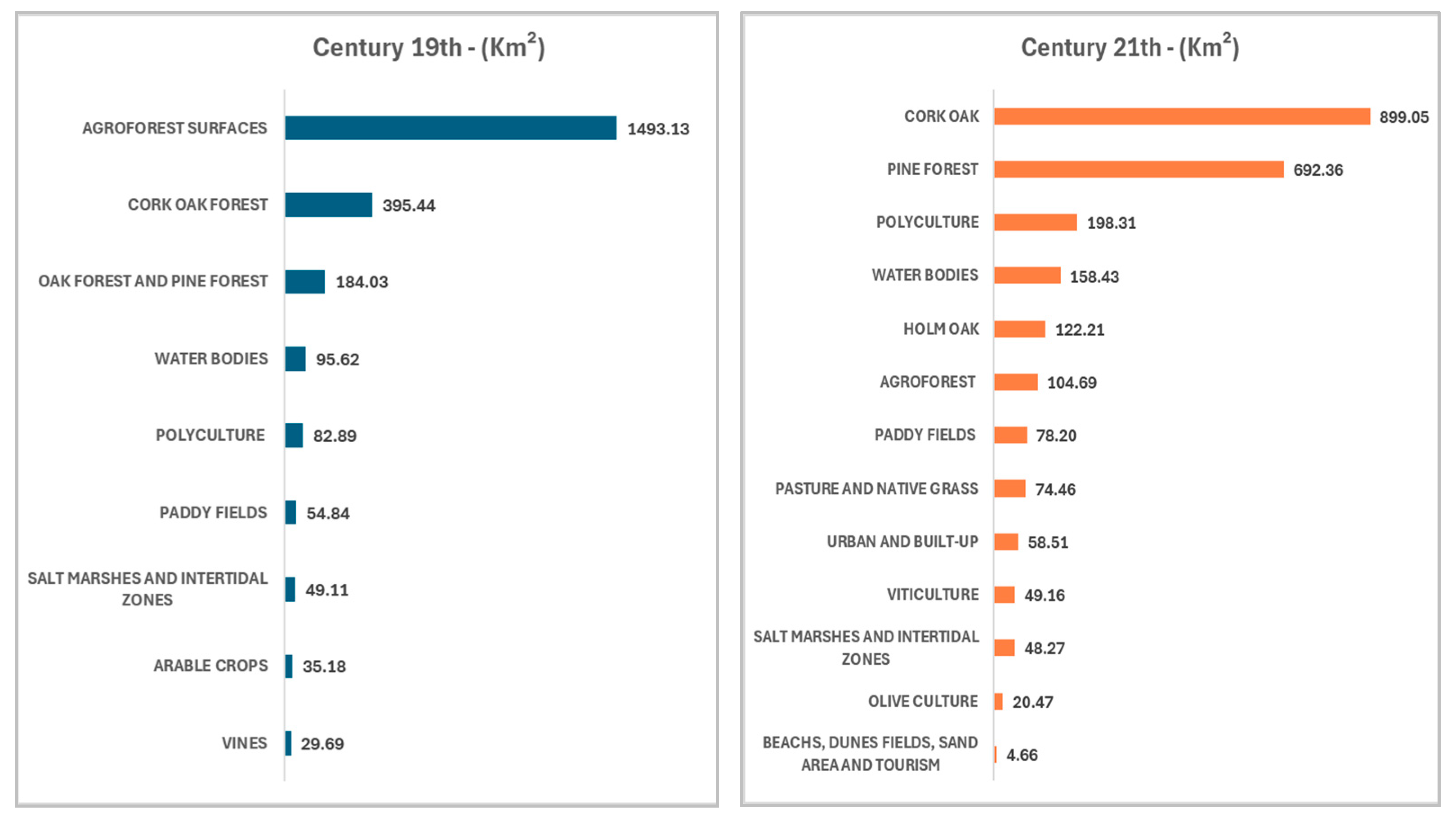
| Land Use | Types of Use (Dominant) | 19th Century Area in km² and (%) of Total | 21st Century Area in km² and (%) of Total | % Change (19th to 21st) |
|---|---|---|---|---|
| Artificial surface | Urban area | 2.4 (0.09%) | 58.51 (2.3%) | +2.437% |
| Agriculture and cropland | Paddy fields | 54.84 (2.26%) | 78.20 (3.11) | +42% |
| Vine | 29.69 (1.22%) | 49.16 (1.95%) | +65.57% | |
| Olive | (1) | 20.47 (0.81%) | ||
| Polyculture | 82.89 (3.42%) | 198.31 (7.90%) | +139.24% | |
| Agroforests and Forests | Cork Oak | 395.44 (16.34%) | 899.05 (35.83%) | +127.35% |
| Pine | (2) | 692.36 (27.60%) | ||
| Holm Oak | (2) | 122.21 (4.87%) | ||
| Mixed vegetation | Agroforest surfaces | 1493.13 (61.70%) (Natural vegetation) | 104.69 (4.17%) | −92.98% |
| Pasture | Pasture and native grasses | (1) | 74.46 (2.96%) | |
| Coastal wetlands | Salt marshes/intertidal | 49.11 (2.02%) | 48.27 (1.72%) | −1.71% |
| Coastal environments | Beaches, dunes, sand | (1) | 4.66 (0.18%) | |
| Other | Water bodies | 95.62 (3.95%) | 158.43 (6.31%) | + 65.68% |
Disclaimer/Publisher’s Note: The statements, opinions and data contained in all publications are solely those of the individual author(s) and contributor(s) and not of MDPI and/or the editor(s). MDPI and/or the editor(s) disclaim responsibility for any injury to people or property resulting from any ideas, methods, instructions or products referred to in the content. |
© 2024 by the authors. Licensee MDPI, Basel, Switzerland. This article is an open access article distributed under the terms and conditions of the Creative Commons Attribution (CC BY) license (https://creativecommons.org/licenses/by/4.0/).
Share and Cite
Alves, N.M.d.S.; Pimentel, N.; Silva, D.B.d.; Inácio, M.; Cunha, A.G.; Freitas, M.d.C. Analysis of Land Use Changes in the Sado Estuary (Portugal) from the 19th to the 21st Century, Based on Historical Maps, Fieldwork, and Remote Sensing. Sustainability 2024, 16, 5798. https://doi.org/10.3390/su16135798
Alves NMdS, Pimentel N, Silva DBd, Inácio M, Cunha AG, Freitas MdC. Analysis of Land Use Changes in the Sado Estuary (Portugal) from the 19th to the 21st Century, Based on Historical Maps, Fieldwork, and Remote Sensing. Sustainability. 2024; 16(13):5798. https://doi.org/10.3390/su16135798
Chicago/Turabian StyleAlves, Neise Mare de Souza, Nuno Pimentel, Débora Barbosa da Silva, Miguel Inácio, Ana Graça Cunha, and Maria da Conceição Freitas. 2024. "Analysis of Land Use Changes in the Sado Estuary (Portugal) from the 19th to the 21st Century, Based on Historical Maps, Fieldwork, and Remote Sensing" Sustainability 16, no. 13: 5798. https://doi.org/10.3390/su16135798
APA StyleAlves, N. M. d. S., Pimentel, N., Silva, D. B. d., Inácio, M., Cunha, A. G., & Freitas, M. d. C. (2024). Analysis of Land Use Changes in the Sado Estuary (Portugal) from the 19th to the 21st Century, Based on Historical Maps, Fieldwork, and Remote Sensing. Sustainability, 16(13), 5798. https://doi.org/10.3390/su16135798







